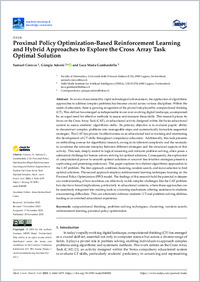Proximal policy optimization-based reinforcement learning and hybrid approaches to explore the cross array task optimal solution
- Corecco, Samuel Facoltà di scienze informatiche, Università della Svizzera italiana, Svizzera
- Adorni, Giorgia ORCID Istituto Dalle Molle di studi sull'intelligenza artificiale (IDSIA), Facoltà di scienze informatiche, Università della Svizzera italiana, Svizzera
- Gambardella, Luca Maria Istituto Dalle Molle di studi sull'intelligenza artificiale (IDSIA), Facoltà di scienze informatiche, Università della Svizzera italiana, Svizzera
- 2023
Published in:
- Machine learning and knowledge extraction. - 2023, vol. 5, no. 4, p. 1660-1679
Computational thinking
Problem-solving techniques
Clustering
Random search
Reinforcement learning
Proximal policy optimization
English
In an era characterised by rapid technological advancement, the application of algorithmic approaches to address complex problems has become crucial across various disciplines. Within the realm of education, there is growing recognition of the pivotal role played by computational thinking (CT). This skill set has emerged as indispensable in our ever-evolving digital landscape, accompanied by an equal need for effective methods to assess and measure these skills. This research places its focus on the Cross Array Task (CAT), an educational activity designed within the Swiss educational system to assess students’ algorithmic skills. Its primary objective is to evaluate pupils’ ability to deconstruct complex problems into manageable steps and systematically formulate sequential strategies. The CAT has proven its effectiveness as an educational tool in tracking and monitoring the development of CT skills throughout compulsory education. Additionally, this task presents an enthralling avenue for algorithmic research, owing to its inherent complexity and the necessity to scrutinise the intricate interplay between different strategies and the structural aspects of this activity. This task, deeply rooted in logical reasoning and intricate problem solving, often poses a substantial challenge for human solvers striving for optimal solutions. Consequently, the exploration of computational power to unearth optimal solutions or uncover less intuitive strategies presents a captivating and promising endeavour. This paper explores two distinct algorithmic approaches to the CAT problem. The first approach combines clustering, random search, and move selection to find optimal solutions. The second approach employs reinforcement learning techniques focusing on the Proximal Policy Optimization (PPO) model. The findings of this research hold the potential to deepen our understanding of how machines can effectively tackle complex challenges like the CAT problem but also have broad implications, particularly in educational contexts, where these approaches can be seamlessly integrated into existing tools as a tutoring mechanism, offering assistance to students encountering difficulties. This can ultimately enhance students’ CT and problem-solving abilities, leading to an enriched educational experience.
- Collections
- Language
-
- English
- Classification
- Computer science and technology
- Related to
- License
- Open access status
- gold
- Identifiers
-
- DOI 10.3390/make5040082
- ARK ark:/12658/srd1326810
- Persistent URL
- https://n2t.net/ark:/12658/srd1326810
Statistics
Document views: 199
File downloads:
- Adorni_2023_MDPI_make: 148
